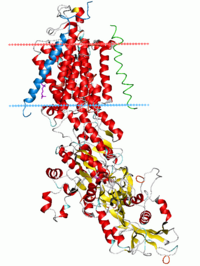
Photo from wikipedia
Studies have shown that hydrogen sulfide (H2S) exerts a neuroprotective effect and may have a therapeutic value for treating neurodegenerative diseases including Parkinson's disease. However, little is known about the… Click to show full abstract
Studies have shown that hydrogen sulfide (H2S) exerts a neuroprotective effect and may have a therapeutic value for treating neurodegenerative diseases including Parkinson's disease. However, little is known about the mechanisms underlying the neuroprotective activity of H2S in vivo. Here, we evaluated the effect of glibenclamide, an ATP-sensitive potassium channel blocker, on the neuroprotective activity of H2S in the 6-hydroxydopamine (6-OHDA) animal model of Parkinson's disease. 6-OHDA was administered by stereotaxic surgery into the medial forebrain bundle. Sodium hydrosulfate (NaHS, 3 and 5.6 mg/kg), as a donor of H2S, alone or in combination with glibenclamide (5 mg/kg), was daily injected for 7 days starting 1–2 h before the stereotaxic surgery. After an apomorphine-induced rotational test, the number of tyrosine hydroxylase-positive neurons in the substantia nigra pars compacta was determined by immunofluorescence. The striatal dopamine level and oxidative stress markers were also measured in brain homogenates. Pretreatment with NaHS significantly attenuated 6-OHDA-induced motor asymmetry in the rotational test. Histological and biochemical evaluations demonstrated that NaHS, especially at high dose, increased the survival of tyrosine hydroxylase-positive neurons in the substantia nigra pars compacta and reduced the decreasing effect of 6-OHDA on striatal dopamine levels. However, co-administration of glibenclamide reversed the antiparkinsonian and neuroprotective effects of NaHS. However, glibenclamide did not change the reducing effect of NaHS on 6-OHDA-induced overproduction of malondialdehyde. Our data show that ATP-sensitive potassium channels are involved in the antiparkinsonian and neuroprotective effects of H2S in the 6-OHDA animal model of Parkinson's disease.
Journal Title: Behavioural Pharmacology
Year Published: 2018
Link to full text (if available)
Share on Social Media: Sign Up to like & get
recommendations!